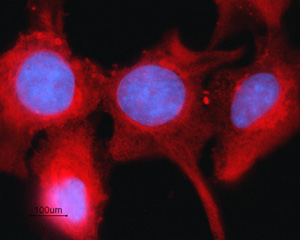Overview
- Peptide (C)HAQPFDFPDDNQNSK, corresponding to amino acids residues 331-345 of human Connexin-43 (Accession P17302). Intracellular, C-terminus.

 Western blot analysis of mouse brain membranes:1. Anti-Connexin-43 Antibody (#ACC-201), (1:400).
Western blot analysis of mouse brain membranes:1. Anti-Connexin-43 Antibody (#ACC-201), (1:400).
2. Anti-Connexin-43 Antibody, preincubated with Connexin-43 Blocking Peptide (#BLP-CC201). Western blot analysis of rat heart membranes:1. Anti-Connexin-43 Antibody (#ACC-201), (1:400).
Western blot analysis of rat heart membranes:1. Anti-Connexin-43 Antibody (#ACC-201), (1:400).
2. Anti-Connexin-43 Antibody, preincubated with Connexin-43 Blocking Peptide (#BLP-CC201).
 Expression of Connexin-43 in rat cerebellumImmunohistochemical staining of immersion-fixed, free floating rat brain frozen sections using Anti-Connexin-43 Antibody (#ACC-201), (1:300). Cx43 staining (red) appeared in Bergmann glial fibers (arrows) in the molecular layer (MOL) and in the granule layer (G). Cell nuclei were stained with DAPI (blue).
Expression of Connexin-43 in rat cerebellumImmunohistochemical staining of immersion-fixed, free floating rat brain frozen sections using Anti-Connexin-43 Antibody (#ACC-201), (1:300). Cx43 staining (red) appeared in Bergmann glial fibers (arrows) in the molecular layer (MOL) and in the granule layer (G). Cell nuclei were stained with DAPI (blue).- Human fetal cochlear sections (Locher, H. et al. (2015) Dev. Neurobiol. 75, 1219.).
 Expression of Connexin-43 in rat intestinal epithelial IEC-6 cellsImmunocytochemical staining of fixed and permeabilized rat intestinal epithelial IEC-6 cells. Cells were stained with Anti-Connexin-43 Antibody (#ACC-201), (1:200), followed by goat anti-rabbit-AlexaFluor-594 secondary antibody (red). Cell nuclei were visualized using Hoechst 33342 (blue).
Expression of Connexin-43 in rat intestinal epithelial IEC-6 cellsImmunocytochemical staining of fixed and permeabilized rat intestinal epithelial IEC-6 cells. Cells were stained with Anti-Connexin-43 Antibody (#ACC-201), (1:200), followed by goat anti-rabbit-AlexaFluor-594 secondary antibody (red). Cell nuclei were visualized using Hoechst 33342 (blue).
- Goodenough, D.A. and Paul, D.L. (2009) Cold Spring Harb. Persp. Biol. 1, a002576.
- Nakagawa, S. et al. (2010) Curr. Opin. Struct. Biol. 20, 423.
- Chew, S.S. et al. (2010) Exp. Neurol. 225, 250.
- Trexler, E.B. et al. (1996) Proc. Natl. Acad. Sci. U.S.A. 93, 5836.
- Hu, X. et al. (2006) Biophys. J. 90, 140.
- Tang, Q. et al. (2009) J. Gen. Physiol. 133, 555.
Connexins (Cx) are integral membrane proteins consisting of four transmembrane domains, two extracellular loops, one intracellular loop and intracellular N- and C-termini. The 21 members belonging to this family form homomeric or heteromeric hexamers generally termed connexons or hemi-channels. In turn, these hemi-channels further assemble in a head-to-head manner, thus forming gap junction channels1,2. Connexins are ubiquitously expressed and their activity is regulated at the expression level and by post-translational modifications1. For example, Connexin-43 (Cx43) protein level is regulated by its turnover rate and by phosphorylation of various residues which ultimately determines its activity rate1.
Gap junctions are usually found in clusters and enable intercellular communication by allowing the passage of small molecules between cells3. They play important roles in different biological processes. These include differentiation, cell cycle synchronization, cellular development, neuronal activity and the immune response2,4,5.
Due to their important roles, mutations in connexins are linked with a number of diseases such as neurodegenerative disorders, skin diseases, deafness, and developmental abnormalities2,5,6.
Application key:
Species reactivity key:
Alomone Labs is pleased to offer a highly specific antibody directed against an epitope of human Connexin-43. Anti-Connexin-43 Antibody (#ACC-201) can be used in western blot, immunohistochemistry and immunocytochemistry applications. It has been designed to recognize Cx43 from human, rat and mouse samples.
Applications
Citations
- Human fetal cochlear sections (1:2000).
Locher, H. et al. (2015) Dev. Neurobiol. 75, 1219.
